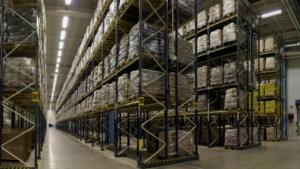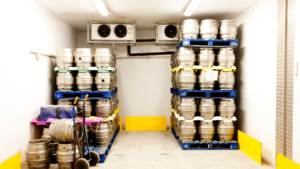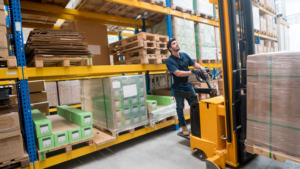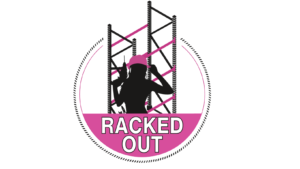You put a lot of effort into your company. Thought and intention goes into the product you produce, the staff you hire, and the pipeline you manage. Yet, when it comes to a company’s warehouse, it is easy to overlook the thought required to build a well integrated system for storage. We’re talking about warehouse design today. Specifically, what necessary factors should be considered in the warehouse design process. If you’re looking to augment or upgrade your warehouse, or even build one from the ground up, stay with us.
What Product Is Your Warehouse Storing?

First thing is first — what is your warehouse storing? Cartons? Skids? Loose items?
If you’re a busy, large-scale bakery, making and chilling dozens of cakes at a time, you’ll need a racking system that can withstand moisture and specific temperatures. In this case, the best storage solution for you would require a galvanized rack system. But if you are a company manufacturing industrial tires, you’ll have vastly different needs.
How To Get Started
Not sure where to start? Think about the type, size, shape and lifespan of your product. All these things become important in the warehouse design process. Ask yourself:
– Is the item perishable?
– Will it be stored in groups on skids, in boxes, or as loose items?
– Do they need protection from the elements during their storage?
Answering these questions is the first step to planning the design of an effective racking system, since different racking systems can offer different specializations.
The main takeaway: build a warehouse around your product, instead of the other way around.
What Are The Best Storage Conditions For Your Product?

We touched on this briefly in our earlier segment, but it bears repeating. Knowing the correct storage conditions for your product helps identify the best racking system in your warehouse design process.
In keeping with our bakery example: different items require different needs. Fruits and vegetables require specific humidities and temperatures. Fresh cut flowers need damp cool environments. But a cool, moist warehouse would be disastrous for a company storing dry goods, like paper products, or clothing.
When thinking about the conditions your product must be kept in, you’ll be wise to consider the time your product will be in storage. The amount of storage time affects the way the system is designed. As a result, the conditions for storing each type of product will vary greatly.
How To Get Started:
When looking at the best storage conditions for your product, begin by asking yourself:
– What is the lifespan of the product?
– How long is it expected to stay in storage?
– What are the ideal conditions for the product to be safely kept in?
The main takeaway: knowing the best conditions for your product is a crucial step to building the right racking system for your warehouse.
How Will The Product In Your Warehouse Be Moved?

Once you know the needs of your product, the next step is to think about how that product needs to physically move.
Think also of the final point-of-sale. Is your warehouse attached to a storefront? Is the product moving to a shipping and receiving location for additional transportation? Perhaps both. In all cases, racking systems can be designed to optimize the movement of your product from storage to end-point.
Let’s go back to our cake and tire comparison. A large-scale bakery will avoid stacking delicate cakes on skids. Instead, they may opt for racking systems that utilize foot-ladders. There are racking systems optimized for precisely this type of product picking.
Further, the perishable bakery item will have a shorter shelf life. This means the storage system should be optimized for fast picking with easy visibility.
On the other hand, a company manufacturing industrial tires would not be well served with the same system. A system engineered to hold heavy skids loaded with large products, pickable with forklifts, would be far better for their needs.
How To Get Started
When considering the type of picking needed for your warehouse racking system, start by thinking about how you want the product to be stored and moved. Ask yourself:
– How long will it remain in storage?
– How many items need to be moved at a time?
– What is the best way to move the product safely?
– How are orders fulfilled and transported to their next location?
These answers help narrow down the specific systems that can be most efficient for your products’ needs.
The main takeaway: Map out the transportation path of your product in your warehouse design process. Where will it move? What is the safest and most efficient way to move it?
Putting Your Data Together To Create The Right Racking System.

Let’s review. We know what our product is. We know the conditions it needs to be kept in. We know how we want to store and access it for movement. We have the map for how it needs to move within the warehouse.
The next step is to think about the best way to organize and access the product so that it can be moved easily and safely. This consideration may sound a lot like our last point, but the unique needs are different.
Generally speaking, warehouses are designed based on the shipping/receiving process they must work within. This falls under basic warehouse management and is the foundation of a well constructed warehouse racking system. It incorporates all previous information on your warehouse’s products and their needs, and uses that data to begin piecing together a custom system for you.
The product and the conditions it needs help determine the style of system. The way it is received, processed, stored, and picked helps determine the racking systems’ layout and style. The machines or tools used to access the product affect the type of racking system and how it is configured.
Finally, the way the product moves from its starting point in your warehouse to the point where it exits your facility, affects the flow of the racking systems’ design.
The main takeaway: Each piece of data about your product and the way it must move is crucial to designing your ideal racking system. Each product and its movement is unique, and thus, each racking system is custom designed for optimal function.
Conclusion
Warehouses are so much more than storage facilities. They are complex ecosystems that move and change alongside your product. When designing a warehouse racking system, the more information you can provide about your product, its lifecycle and its pipeline process, the better able you will be to build the best racking system for your needs.
Racking installation companies like our own have skilled teams in house that can consult and design systems unique to your product. Racked Out offers full turnkey services, from consultation and design, to installation. What’s more, we offer long-term care, replacements and maintenance programs, training for loading rack, and pre-start safety reviews.
If you’re looking for an upgrade, augmentation or new build for your warehouse racking system, give Racked Out a call today.

